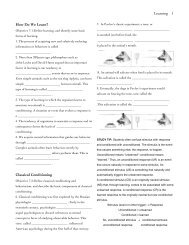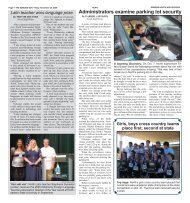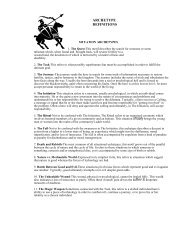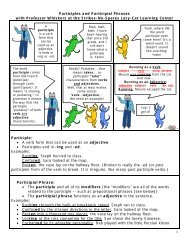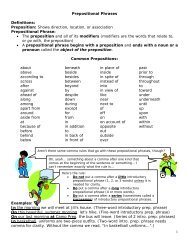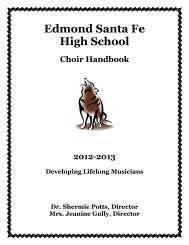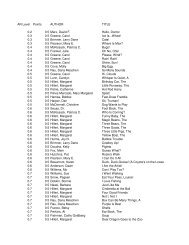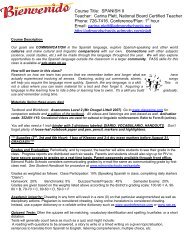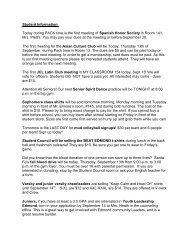1 SEE AGGRESSION ... DO AGGRESSION! - Edmond Public Schools
1 SEE AGGRESSION ... DO AGGRESSION! - Edmond Public Schools
1 SEE AGGRESSION ... DO AGGRESSION! - Edmond Public Schools
You also want an ePaper? Increase the reach of your titles
YUMPU automatically turns print PDFs into web optimized ePapers that Google loves.
2<br />
4. "Since aggression is a highly masculine-typed behavior in society, boys should be more predisposed than<br />
girls toward imitating aggression, the difference being most marked for subjects exposed to the male<br />
model" (p. 575).<br />
METHOD<br />
This article outlined the methods used in the experiment with great organization and clarity. Although somewhat<br />
summarized and simplified, these methodological steps are presented here.<br />
Subjects<br />
The researchers enlisted the help of the director and head teacher of the Stanford University Nursery School in<br />
order to obtain subjects for their study. Thirty-six boys and 36 girls, ranging in age from 3 years to almost 6<br />
years, participated in the study as subjects. The average age of the children was 4 years and 4 months.<br />
Experimental Conditions<br />
Twenty-four children were assigned to the control group, which meant that they would not be exposed to any<br />
model. The remaining 48 subjects were first divided into two groups: one exposed to aggressive models and the<br />
other exposed to nonaggressive models. These groups were divided again into male and female subjects. Finally,<br />
each of these groups were divided so that half of the subjects were exposed to same-sex models and half to<br />
opposite-sex models. This created a total of eight experimental groups and one control group. A question you<br />
might be asking yourself is this: What if the children in some of the groups are already more aggressive than<br />
others? Bandura guarded against this potential problem by obtaining ratings of each subject's level of<br />
aggressiveness. The children were rated by an experimenter and a teacher (both of whom knew the children<br />
well) on their levels of physical aggression, verbal aggression, and aggression toward objects. These ratings<br />
allowed the researchers to match all the groups in terms of average aggression level.<br />
The Experimental Procedure<br />
Each child was exposed individually to the various experimental procedures. First, the experimenter brought the<br />
child to the playroom. On the way, they encountered the adult model who was invited by the experimenter to<br />
come and join in the game. The child was seated in one corner of the playroom at a table containing highly<br />
interesting activities. There were potato prints (this was 1961, so for those of you who have grown up in the<br />
high-tech age, a potato print is a potato cut in half and carved so that, like a rubber stamp, it will reproduce<br />
geometric shapes when inked on a stamp pad) and stickers of brightly colored animals and flowers that could be<br />
pasted onto a poster. Next, the adult model was taken to a table in a different corner containing a tinker toy set, a<br />
mallet, and an inflated Bobo doll 5 feet tall. The experimenter explained that these toys were for the model to<br />
play with and then left the room.<br />
For both the aggressive and nonaggressive conditions, the model began assembling the tinker toys.<br />
However, in the aggressive condition, after a minute, the model attacked the Bobo doll with violence. For all the<br />
subjects in the aggressive condition, the sequence of aggressive acts performed by the model was identical:<br />
The model laid Bobo on its side, sat on it, and punched it repeatedly in the nose. The model then raised<br />
the Bobo doll, picked up the mallet, and struck the doll on the head. Following the mallet aggression, the<br />
model tossed the doll up in the air aggressively, and kicked it about the room. This sequence of<br />
physically aggressive acts was repeated three times, interspersed with verbally aggressive responses<br />
such as, "Sock him in the nose ... , Hit him down ... , Throw him in the air ... , Kick him ... , Pow ... ," and<br />
two non-aggressive comments, "He keeps coming hack for more" and "He sure is a tough fella." (p. 576)<br />
All this took about 10 minutes, after which tl1e experimenter came back into the room, said good-bye to the<br />
model, and took the child to another game room.<br />
In the nonaggressive condition, the model simply played quietly with the tinker toys for the 10-minute<br />
period and completely ignored the Bobo doll. Bandura and his collaborators were careful to ensure that all<br />
experimental factors were identical for all the subjects except for the factors being studied: the aggressive versus<br />
nonaggressive model and the sex of the model.



